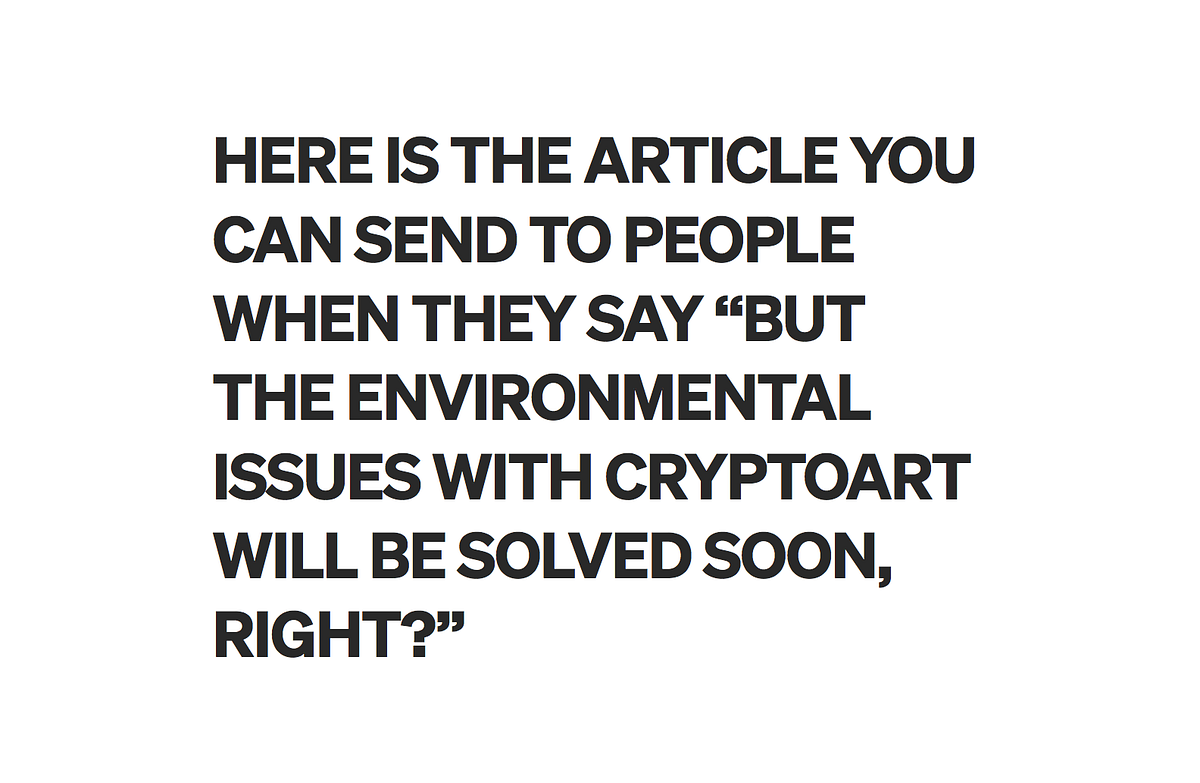The Environmental Cost of CryptoArt

I want to talk a little bit about the environmental cost of blockchain technologies - and in particular the recent gold rush around crypto-art and NFTs. I've seen a lot of crazed excitement about this around my networks, and I think it's important to have all the information before you dive into this new, exciting thing.
For those who are a little bit fuzzy about how blockchains work, a key component is "proof of work" (there are other ways to run a blockchain, but this is the way that's used by all the major players right now). You ask a computer to solve a bunch of complex equations, which validate transactions elsewhere on the network, and you get rewarded for that transaction with cryptocurrency like Bitcoin or Ethereum. This is called "mining".
The problem is that solving a bunch of complex equations requires a lot of computing power, which in turn requires electricity. While renewable energy is becoming more common, most grids are still dominated by fossil fuels - particularly in China, where most mining takes place. Computational artist Memo Akten has calculated that the average Ethereum transaction has a carbon footprint of about 20kg CO2 equivalent.
It gets worse. A single cryptoart NFT ("non-fungible token" - which cryptoart folks have declared to represent the ownership of a digital artwork) involves potentially dozens of transactions. Akten analysed 18,000 of these tokens, finding that the average NFT has a footprint of around 211 kg of CO2 equivalent. That's the same as an EU resident's electric power consumption for more than a month, driving for 1000km, or a return flight from London to Rome. And that's just for keeping track of who owns it - it doesn't include the energy consumption used in the creation of the work, its storage, or the website it's hosted on.
Somehow crypto art lives in the almost infinitesimally small corner case where artists getting paid for their art is actually bad.
— Andy Wallace! (@Andy_Makes) February 26, 2021
Many cryptoartists churn out these NFTs, hoping to strike gold with one or two. This means that the average footprint of the work of a single cryptoartist is about six tonnes of CO2 - which in developed countries will pretty much double that person's annual carbon footprint.
With me still? Great. Because we haven't talked about "editions" yet. The above analysis covers one-off NFTs, where there's only a single token for each artwork. That's how marketplaces like SuperRare work. But there are other marketplaces, like NiftyGateway, that allow creators to sell the same work more than once - so lots of people can "own" a copy. That's nice for people who want to own copies. But if you sell 100 copies, you multiply your carbon footprint by 100.

Joanie Lemercier is a digital artist who released a series of artworks of the platonic solids on NiftyGateway. He issued it in an edition of 53. It sold out in 10 seconds, and he eagerly started preparing a second release. But on the day it was due to drop, he published a blog post instead, calculating that his first release "consumed in 10 seconds more electricity than the entire studio over the past 2 years". He wrote:
"Today was supposed to be my second CryptoArt release on NiftyGateway. Considering the insane and unnecessary waste of electricity involved, I’ve decided to cancel the drop until the issue is addressed."
If you're a digital artist considering releasing your work as an NFT, then I'd urge you to do the same. If you're not, and you want to get a sense of how much carbon is being emitted by the buying and selling of different digital artworks (and how ugly many of them are!) then check out http://cryptoart.wtf, also created by Memo Akten.

And while this is all about cryptoart, the same calculations apply to basically everything that's on the blockchain right now. Owning bitcoin, ethereum, or other cryptocurrencies, will balloon your carbon footprint far more than you likely imagine. It's honestly terrifying.
There are lots of other reasons to be skeptical about the value of cryptoart. But this is mine.
If you enjoyed this post, you might also enjoy my newsletter - which it was originally written for. Sign up here and unsubscribe at any time.
Update 2021-03-08:
Following on from the above writings about the environmental costs of crypoart, a bunch of people sent me words to the effect of "but the environmental issues with cryptoart will be solved soon, right?", to which I replied with a link to this article by excellent internet person Everest Pipkin:

The most common thing I heard is that the Ethereum blockchain, which most cryptoart services run on, is planning to switch from the energy-intensive "Proof of Work" system to a more environmentally-friendly "Proof of Stake" system in Summer 2021. To which Pipkin writes:
Ethereum “has been moving” to proof of stake for almost as long as it has existed. It has been so long that “Eth 2.0 PoS Coming Soon!” is something of a running joke. In all that time, any time the ecological cost of PoW is brought up, PoS is touted as the redemption just over the hill- if we can just hang on another few months, the whole network will be green. Meanwhile, the Ethereum networks’s annual energy consumption is hovering around 24.43 TWh — roughly equivalent to the entire country of Ecuador. Even if Ethereum does manage to make the switch someday, we truly don’t have time to wait.
Pipkin also touches a lot on the social justice issues around cryptocurrencies, which are explicitly designed so that you make money from the people who have entered the market after you.
The value continuing to rise absolutely depends on ever more users joining the network, using coins, and competing to mine them.
I strongly suspect that this is why a lot of people who were totally uninterested in digital art a few years ago are now extremely interested in digital art. Because it's a way to create a buzz that makes their cryptocurrency holdings more valuable.
One more thing: I've seen a lot of people saying that they've bought offsets for their NFTs, as if that's some sort of "get out of jail free" card.
I have complicated feelings about offsets. Many folks in the climate movement reject them completely (often with an analogy to the "indulgences" that the Catholic Church sold in the Middle Ages for people to offset their sins). There are a lot of shady companies selling offsets that turn out to not actually void the carbon they promise to, and a lot of reputable firms doing the same thing unknowingly.
On the other hand, financing a transition from a society that is actively destroying the planet to one that is not actively destroying the planet is not simple. Offsets are one of several ways to fund projects that take us closer to that goal, especially projects in developing countries, where public finance is much harder to come by. There is value in that, even if not all those projects work out.
I offset my personal and business emissions (as well as reducing them on an annual basis to the extent that I can), by buying high-quality offsets from offset certification body Gold Standard. I'm proud to be "carbon neutral" in this way (and declare myself as such on my website), but I don't kid myself that doing this in any way compensates for the environmental damage that those emissions are causing.
If pressed, I would probably say something like "offsets can be useful, but rarely deliver what they promise and are woefully insufficient". They're merely a single brick in the wall of climate solutions, and a small, weirdly-shaped brick at that.
So please don't think that paying someone in a developing country to plant trees on their farmland and totally change their way of life just so that you can drop a new NFT (or fly around the world on holiday) is in any way a solution to the climate crisis. It's just not that simple.
😌😌😌 pic.twitter.com/x40S5tT5ML
— Duncan Geere 🔰 (@duncangeere) March 7, 2021


